Harvey Norman Financial Report: Accounting Theory & Ratio Analysis
VerifiedAdded on 2023/06/08
|22
|4128
|105
Report
AI Summary
This report provides a comprehensive analysis of Harvey Norman's financial statements, applying key financial ratios, accounting standards, and conceptual frameworks. It examines the company's market position, competitive forces, and adherence to AASB and IFRS standards. The analysis includes a review of contingent liabilities, corporate governance, and a competitor analysis focusing on firms like Woolworths and Myer Holdings Ltd. Ratio analysis, including current ratio, quick ratio, gearing ratio, and profit margin ratios, reveals insights into the company's profitability and liquidity. The report concludes with recommendations based on the financial analysis, offering a perspective on whether to invest in Harvey Norman based on its financial performance and market position. Desklib provides a platform for students to access similar solved assignments and past papers for academic assistance.
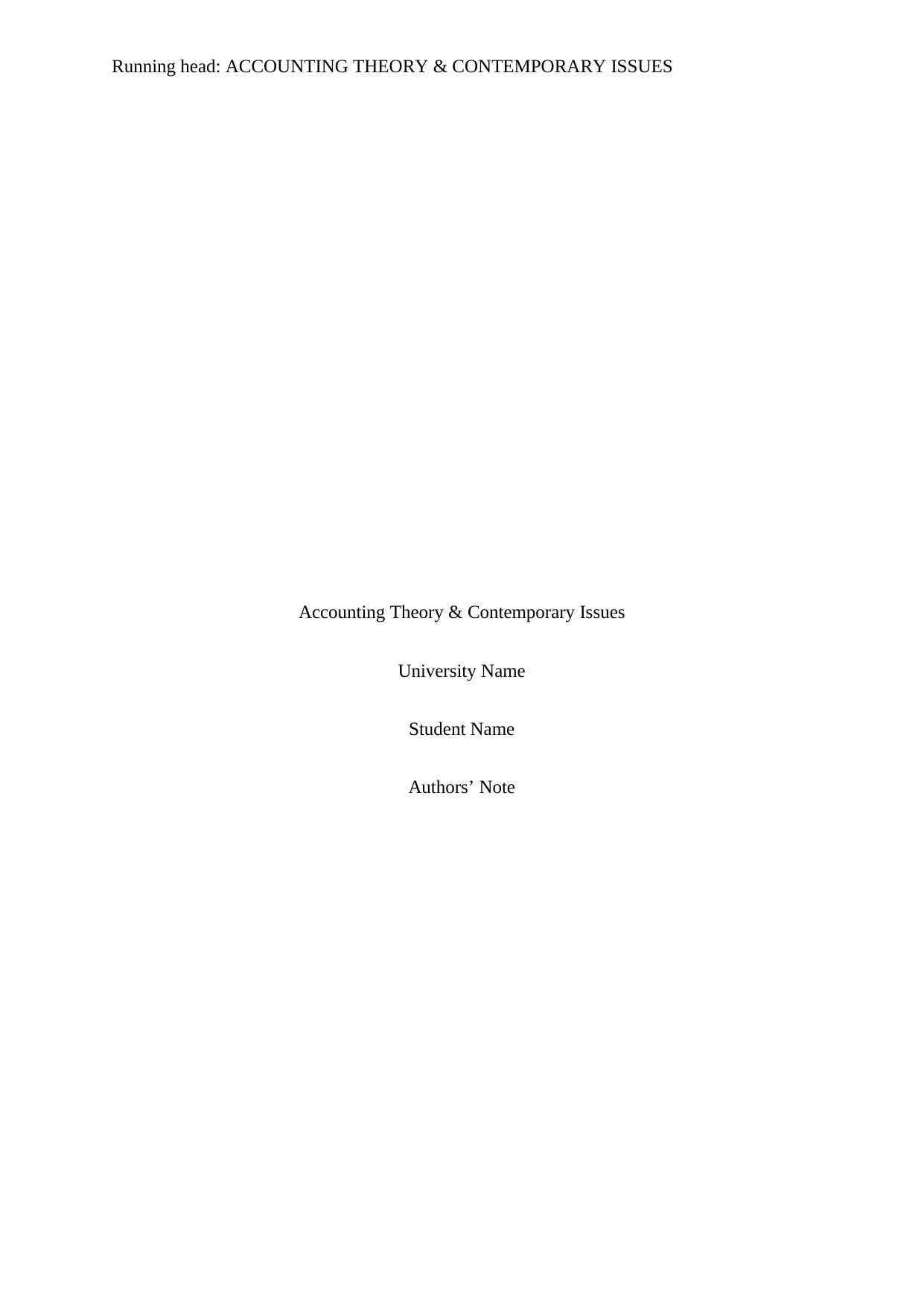
Running head: ACCOUNTING THEORY & CONTEMPORARY ISSUES
Accounting Theory & Contemporary Issues
University Name
Student Name
Authors’ Note
Accounting Theory & Contemporary Issues
University Name
Student Name
Authors’ Note
Paraphrase This Document
Need a fresh take? Get an instant paraphrase of this document with our AI Paraphraser
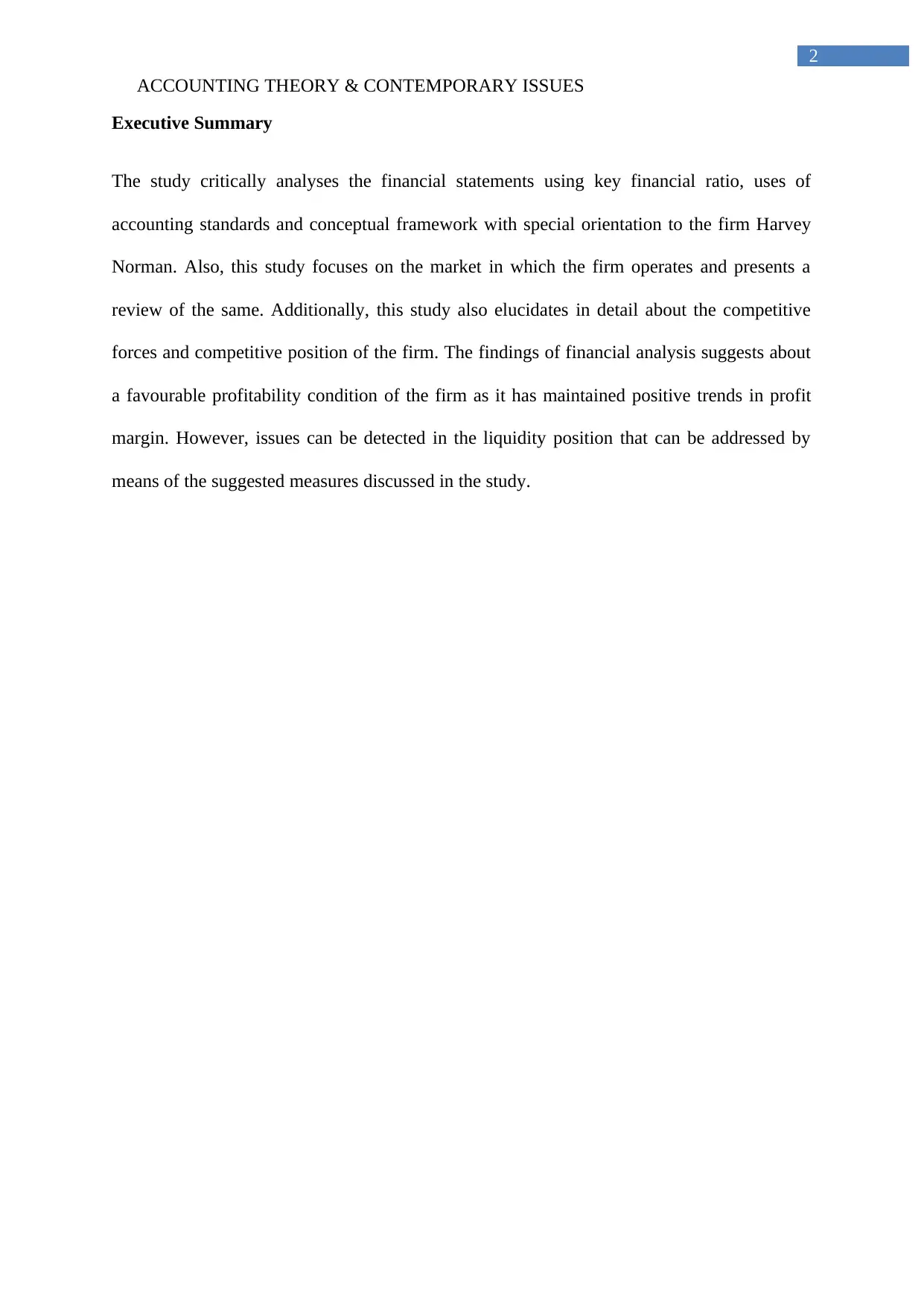
2
ACCOUNTING THEORY & CONTEMPORARY ISSUES
Executive Summary
The study critically analyses the financial statements using key financial ratio, uses of
accounting standards and conceptual framework with special orientation to the firm Harvey
Norman. Also, this study focuses on the market in which the firm operates and presents a
review of the same. Additionally, this study also elucidates in detail about the competitive
forces and competitive position of the firm. The findings of financial analysis suggests about
a favourable profitability condition of the firm as it has maintained positive trends in profit
margin. However, issues can be detected in the liquidity position that can be addressed by
means of the suggested measures discussed in the study.
ACCOUNTING THEORY & CONTEMPORARY ISSUES
Executive Summary
The study critically analyses the financial statements using key financial ratio, uses of
accounting standards and conceptual framework with special orientation to the firm Harvey
Norman. Also, this study focuses on the market in which the firm operates and presents a
review of the same. Additionally, this study also elucidates in detail about the competitive
forces and competitive position of the firm. The findings of financial analysis suggests about
a favourable profitability condition of the firm as it has maintained positive trends in profit
margin. However, issues can be detected in the liquidity position that can be addressed by
means of the suggested measures discussed in the study.

3
ACCOUNTING THEORY & CONTEMPORARY ISSUES
Table of Contents
Introduction................................................................................................................................4
Body...........................................................................................................................................4
-Current Market Analysis of the company.............................................................................4
-Accounting Standards used by the company........................................................................4
-Contingent liability of the company.....................................................................................6
-Conceptual Framework.........................................................................................................6
-Competitor Analysis of the company...................................................................................7
-Ratio Analysis of the company.............................................................................................8
Recommendations................................................................................................................13
Conclusion............................................................................................................................14
References................................................................................................................................15
Appendix..............................................................................................................................17
INCOME STATEMENT.....................................................................................................17
BALANCE SHEET.............................................................................................................18
Ratio Analysis......................................................................................................................20
ACCOUNTING THEORY & CONTEMPORARY ISSUES
Table of Contents
Introduction................................................................................................................................4
Body...........................................................................................................................................4
-Current Market Analysis of the company.............................................................................4
-Accounting Standards used by the company........................................................................4
-Contingent liability of the company.....................................................................................6
-Conceptual Framework.........................................................................................................6
-Competitor Analysis of the company...................................................................................7
-Ratio Analysis of the company.............................................................................................8
Recommendations................................................................................................................13
Conclusion............................................................................................................................14
References................................................................................................................................15
Appendix..............................................................................................................................17
INCOME STATEMENT.....................................................................................................17
BALANCE SHEET.............................................................................................................18
Ratio Analysis......................................................................................................................20
⊘ This is a preview!⊘
Do you want full access?
Subscribe today to unlock all pages.

Trusted by 1+ million students worldwide
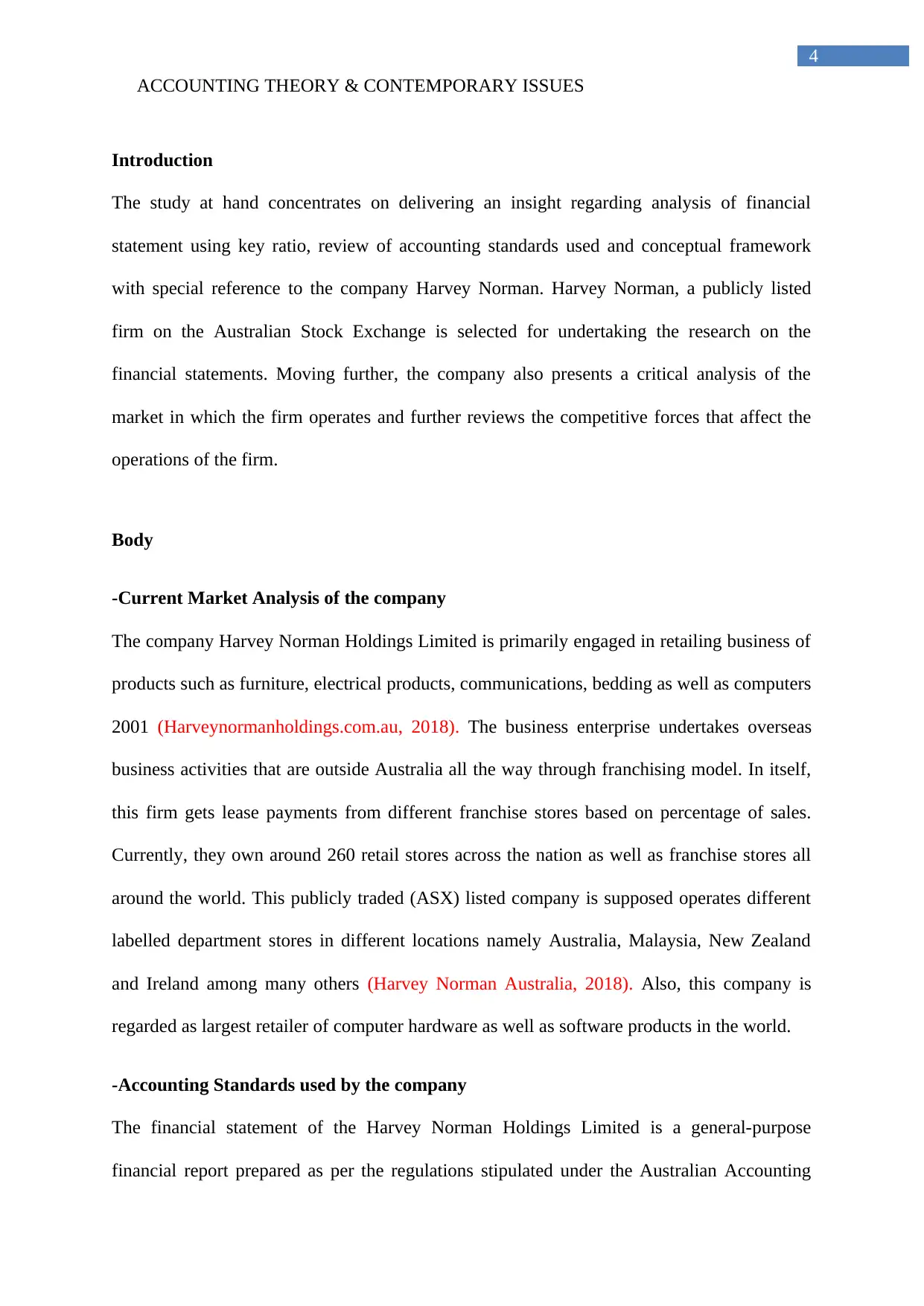
4
ACCOUNTING THEORY & CONTEMPORARY ISSUES
Introduction
The study at hand concentrates on delivering an insight regarding analysis of financial
statement using key ratio, review of accounting standards used and conceptual framework
with special reference to the company Harvey Norman. Harvey Norman, a publicly listed
firm on the Australian Stock Exchange is selected for undertaking the research on the
financial statements. Moving further, the company also presents a critical analysis of the
market in which the firm operates and further reviews the competitive forces that affect the
operations of the firm.
Body
-Current Market Analysis of the company
The company Harvey Norman Holdings Limited is primarily engaged in retailing business of
products such as furniture, electrical products, communications, bedding as well as computers
2001 (Harveynormanholdings.com.au, 2018). The business enterprise undertakes overseas
business activities that are outside Australia all the way through franchising model. In itself,
this firm gets lease payments from different franchise stores based on percentage of sales.
Currently, they own around 260 retail stores across the nation as well as franchise stores all
around the world. This publicly traded (ASX) listed company is supposed operates different
labelled department stores in different locations namely Australia, Malaysia, New Zealand
and Ireland among many others (Harvey Norman Australia, 2018). Also, this company is
regarded as largest retailer of computer hardware as well as software products in the world.
-Accounting Standards used by the company
The financial statement of the Harvey Norman Holdings Limited is a general-purpose
financial report prepared as per the regulations stipulated under the Australian Accounting
ACCOUNTING THEORY & CONTEMPORARY ISSUES
Introduction
The study at hand concentrates on delivering an insight regarding analysis of financial
statement using key ratio, review of accounting standards used and conceptual framework
with special reference to the company Harvey Norman. Harvey Norman, a publicly listed
firm on the Australian Stock Exchange is selected for undertaking the research on the
financial statements. Moving further, the company also presents a critical analysis of the
market in which the firm operates and further reviews the competitive forces that affect the
operations of the firm.
Body
-Current Market Analysis of the company
The company Harvey Norman Holdings Limited is primarily engaged in retailing business of
products such as furniture, electrical products, communications, bedding as well as computers
2001 (Harveynormanholdings.com.au, 2018). The business enterprise undertakes overseas
business activities that are outside Australia all the way through franchising model. In itself,
this firm gets lease payments from different franchise stores based on percentage of sales.
Currently, they own around 260 retail stores across the nation as well as franchise stores all
around the world. This publicly traded (ASX) listed company is supposed operates different
labelled department stores in different locations namely Australia, Malaysia, New Zealand
and Ireland among many others (Harvey Norman Australia, 2018). Also, this company is
regarded as largest retailer of computer hardware as well as software products in the world.
-Accounting Standards used by the company
The financial statement of the Harvey Norman Holdings Limited is a general-purpose
financial report prepared as per the regulations stipulated under the Australian Accounting
Paraphrase This Document
Need a fresh take? Get an instant paraphrase of this document with our AI Paraphraser
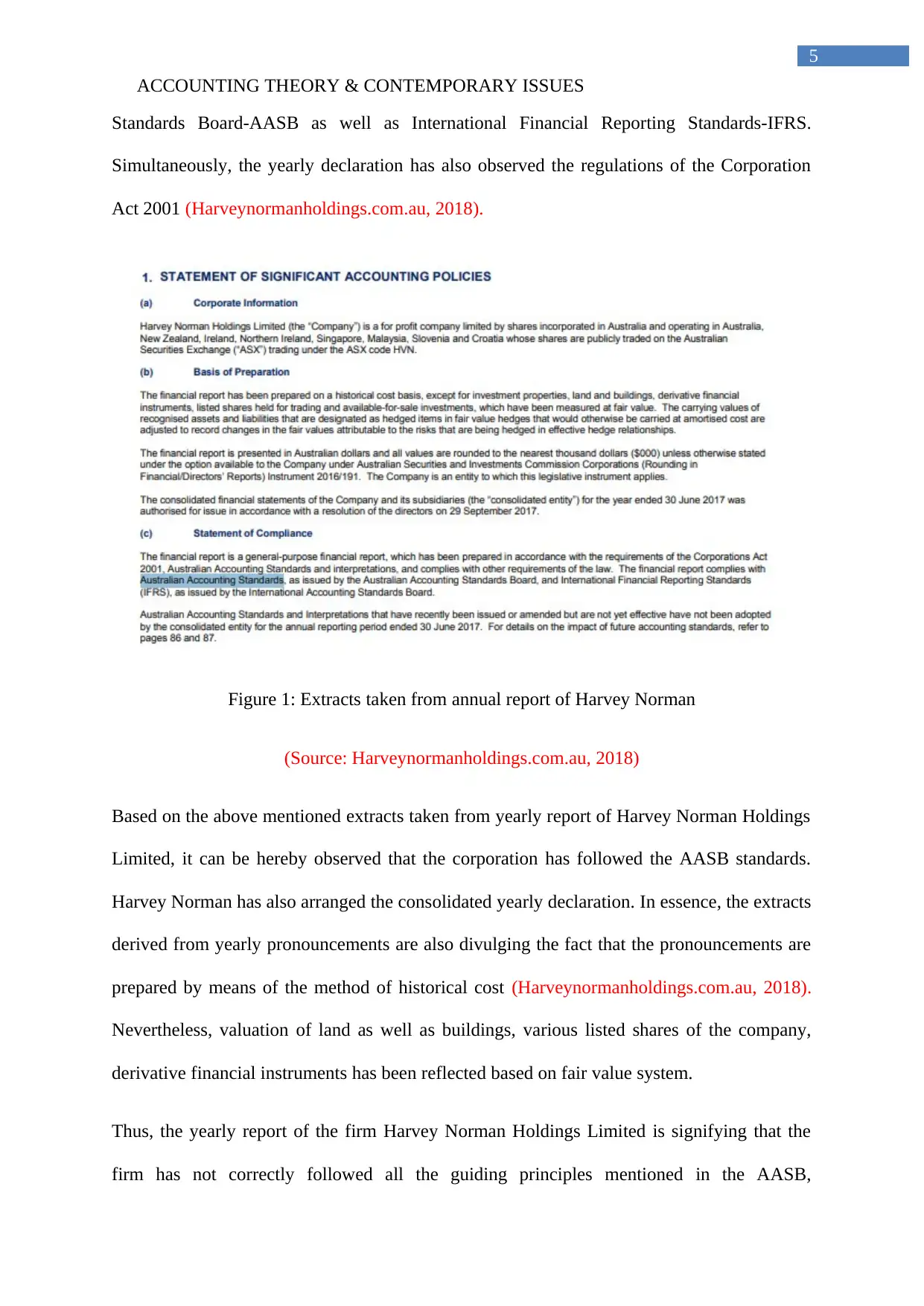
5
ACCOUNTING THEORY & CONTEMPORARY ISSUES
Standards Board-AASB as well as International Financial Reporting Standards-IFRS.
Simultaneously, the yearly declaration has also observed the regulations of the Corporation
Act 2001 (Harveynormanholdings.com.au, 2018).
Figure 1: Extracts taken from annual report of Harvey Norman
(Source: Harveynormanholdings.com.au, 2018)
Based on the above mentioned extracts taken from yearly report of Harvey Norman Holdings
Limited, it can be hereby observed that the corporation has followed the AASB standards.
Harvey Norman has also arranged the consolidated yearly declaration. In essence, the extracts
derived from yearly pronouncements are also divulging the fact that the pronouncements are
prepared by means of the method of historical cost (Harveynormanholdings.com.au, 2018).
Nevertheless, valuation of land as well as buildings, various listed shares of the company,
derivative financial instruments has been reflected based on fair value system.
Thus, the yearly report of the firm Harvey Norman Holdings Limited is signifying that the
firm has not correctly followed all the guiding principles mentioned in the AASB,
ACCOUNTING THEORY & CONTEMPORARY ISSUES
Standards Board-AASB as well as International Financial Reporting Standards-IFRS.
Simultaneously, the yearly declaration has also observed the regulations of the Corporation
Act 2001 (Harveynormanholdings.com.au, 2018).
Figure 1: Extracts taken from annual report of Harvey Norman
(Source: Harveynormanholdings.com.au, 2018)
Based on the above mentioned extracts taken from yearly report of Harvey Norman Holdings
Limited, it can be hereby observed that the corporation has followed the AASB standards.
Harvey Norman has also arranged the consolidated yearly declaration. In essence, the extracts
derived from yearly pronouncements are also divulging the fact that the pronouncements are
prepared by means of the method of historical cost (Harveynormanholdings.com.au, 2018).
Nevertheless, valuation of land as well as buildings, various listed shares of the company,
derivative financial instruments has been reflected based on fair value system.
Thus, the yearly report of the firm Harvey Norman Holdings Limited is signifying that the
firm has not correctly followed all the guiding principles mentioned in the AASB,
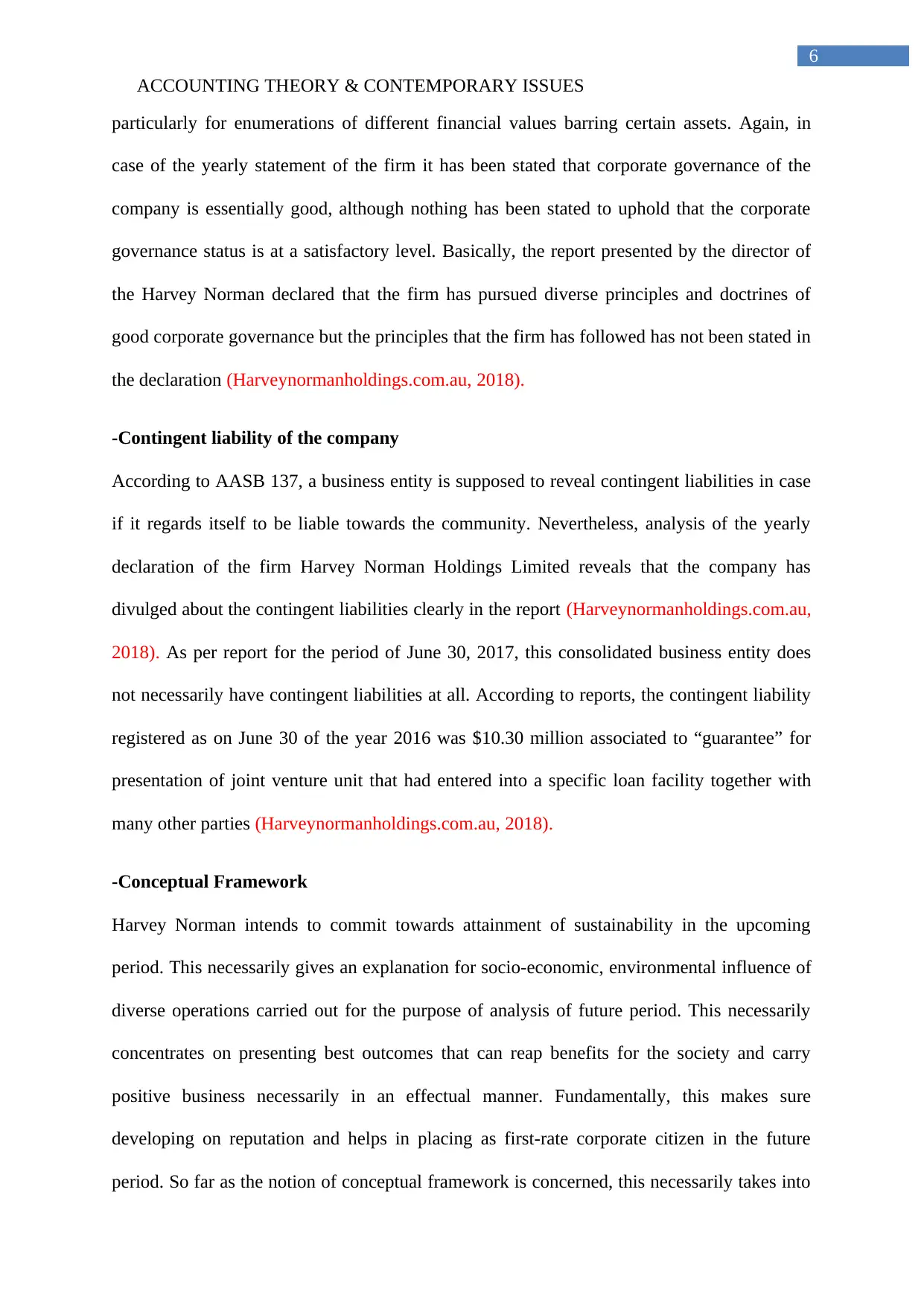
6
ACCOUNTING THEORY & CONTEMPORARY ISSUES
particularly for enumerations of different financial values barring certain assets. Again, in
case of the yearly statement of the firm it has been stated that corporate governance of the
company is essentially good, although nothing has been stated to uphold that the corporate
governance status is at a satisfactory level. Basically, the report presented by the director of
the Harvey Norman declared that the firm has pursued diverse principles and doctrines of
good corporate governance but the principles that the firm has followed has not been stated in
the declaration (Harveynormanholdings.com.au, 2018).
-Contingent liability of the company
According to AASB 137, a business entity is supposed to reveal contingent liabilities in case
if it regards itself to be liable towards the community. Nevertheless, analysis of the yearly
declaration of the firm Harvey Norman Holdings Limited reveals that the company has
divulged about the contingent liabilities clearly in the report (Harveynormanholdings.com.au,
2018). As per report for the period of June 30, 2017, this consolidated business entity does
not necessarily have contingent liabilities at all. According to reports, the contingent liability
registered as on June 30 of the year 2016 was $10.30 million associated to “guarantee” for
presentation of joint venture unit that had entered into a specific loan facility together with
many other parties (Harveynormanholdings.com.au, 2018).
-Conceptual Framework
Harvey Norman intends to commit towards attainment of sustainability in the upcoming
period. This necessarily gives an explanation for socio-economic, environmental influence of
diverse operations carried out for the purpose of analysis of future period. This necessarily
concentrates on presenting best outcomes that can reap benefits for the society and carry
positive business necessarily in an effectual manner. Fundamentally, this makes sure
developing on reputation and helps in placing as first-rate corporate citizen in the future
period. So far as the notion of conceptual framework is concerned, this necessarily takes into
ACCOUNTING THEORY & CONTEMPORARY ISSUES
particularly for enumerations of different financial values barring certain assets. Again, in
case of the yearly statement of the firm it has been stated that corporate governance of the
company is essentially good, although nothing has been stated to uphold that the corporate
governance status is at a satisfactory level. Basically, the report presented by the director of
the Harvey Norman declared that the firm has pursued diverse principles and doctrines of
good corporate governance but the principles that the firm has followed has not been stated in
the declaration (Harveynormanholdings.com.au, 2018).
-Contingent liability of the company
According to AASB 137, a business entity is supposed to reveal contingent liabilities in case
if it regards itself to be liable towards the community. Nevertheless, analysis of the yearly
declaration of the firm Harvey Norman Holdings Limited reveals that the company has
divulged about the contingent liabilities clearly in the report (Harveynormanholdings.com.au,
2018). As per report for the period of June 30, 2017, this consolidated business entity does
not necessarily have contingent liabilities at all. According to reports, the contingent liability
registered as on June 30 of the year 2016 was $10.30 million associated to “guarantee” for
presentation of joint venture unit that had entered into a specific loan facility together with
many other parties (Harveynormanholdings.com.au, 2018).
-Conceptual Framework
Harvey Norman intends to commit towards attainment of sustainability in the upcoming
period. This necessarily gives an explanation for socio-economic, environmental influence of
diverse operations carried out for the purpose of analysis of future period. This necessarily
concentrates on presenting best outcomes that can reap benefits for the society and carry
positive business necessarily in an effectual manner. Fundamentally, this makes sure
developing on reputation and helps in placing as first-rate corporate citizen in the future
period. So far as the notion of conceptual framework is concerned, this necessarily takes into
⊘ This is a preview!⊘
Do you want full access?
Subscribe today to unlock all pages.

Trusted by 1+ million students worldwide
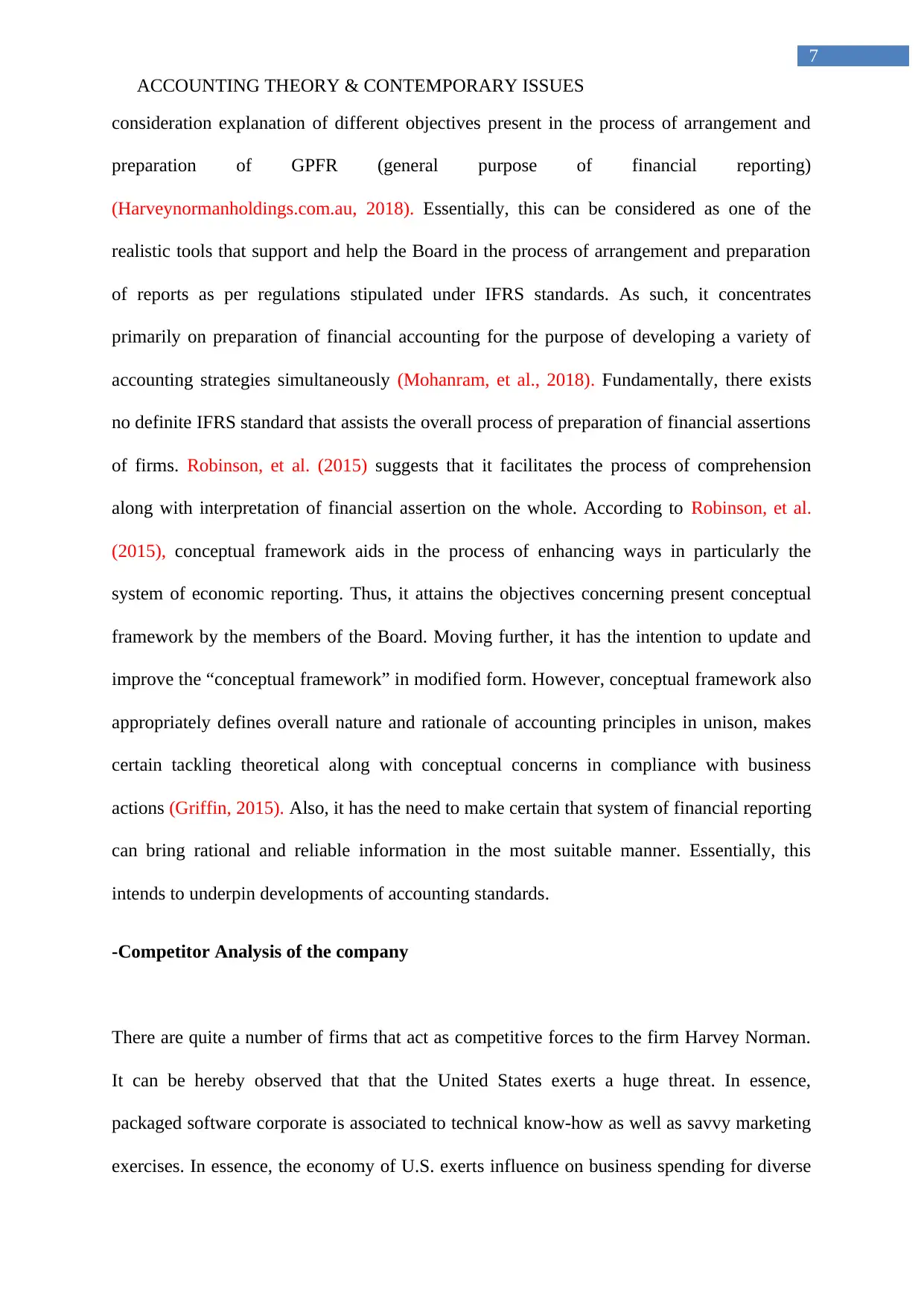
7
ACCOUNTING THEORY & CONTEMPORARY ISSUES
consideration explanation of different objectives present in the process of arrangement and
preparation of GPFR (general purpose of financial reporting)
(Harveynormanholdings.com.au, 2018). Essentially, this can be considered as one of the
realistic tools that support and help the Board in the process of arrangement and preparation
of reports as per regulations stipulated under IFRS standards. As such, it concentrates
primarily on preparation of financial accounting for the purpose of developing a variety of
accounting strategies simultaneously (Mohanram, et al., 2018). Fundamentally, there exists
no definite IFRS standard that assists the overall process of preparation of financial assertions
of firms. Robinson, et al. (2015) suggests that it facilitates the process of comprehension
along with interpretation of financial assertion on the whole. According to Robinson, et al.
(2015), conceptual framework aids in the process of enhancing ways in particularly the
system of economic reporting. Thus, it attains the objectives concerning present conceptual
framework by the members of the Board. Moving further, it has the intention to update and
improve the “conceptual framework” in modified form. However, conceptual framework also
appropriately defines overall nature and rationale of accounting principles in unison, makes
certain tackling theoretical along with conceptual concerns in compliance with business
actions (Griffin, 2015). Also, it has the need to make certain that system of financial reporting
can bring rational and reliable information in the most suitable manner. Essentially, this
intends to underpin developments of accounting standards.
-Competitor Analysis of the company
There are quite a number of firms that act as competitive forces to the firm Harvey Norman.
It can be hereby observed that that the United States exerts a huge threat. In essence,
packaged software corporate is associated to technical know-how as well as savvy marketing
exercises. In essence, the economy of U.S. exerts influence on business spending for diverse
ACCOUNTING THEORY & CONTEMPORARY ISSUES
consideration explanation of different objectives present in the process of arrangement and
preparation of GPFR (general purpose of financial reporting)
(Harveynormanholdings.com.au, 2018). Essentially, this can be considered as one of the
realistic tools that support and help the Board in the process of arrangement and preparation
of reports as per regulations stipulated under IFRS standards. As such, it concentrates
primarily on preparation of financial accounting for the purpose of developing a variety of
accounting strategies simultaneously (Mohanram, et al., 2018). Fundamentally, there exists
no definite IFRS standard that assists the overall process of preparation of financial assertions
of firms. Robinson, et al. (2015) suggests that it facilitates the process of comprehension
along with interpretation of financial assertion on the whole. According to Robinson, et al.
(2015), conceptual framework aids in the process of enhancing ways in particularly the
system of economic reporting. Thus, it attains the objectives concerning present conceptual
framework by the members of the Board. Moving further, it has the intention to update and
improve the “conceptual framework” in modified form. However, conceptual framework also
appropriately defines overall nature and rationale of accounting principles in unison, makes
certain tackling theoretical along with conceptual concerns in compliance with business
actions (Griffin, 2015). Also, it has the need to make certain that system of financial reporting
can bring rational and reliable information in the most suitable manner. Essentially, this
intends to underpin developments of accounting standards.
-Competitor Analysis of the company
There are quite a number of firms that act as competitive forces to the firm Harvey Norman.
It can be hereby observed that that the United States exerts a huge threat. In essence,
packaged software corporate is associated to technical know-how as well as savvy marketing
exercises. In essence, the economy of U.S. exerts influence on business spending for diverse
Paraphrase This Document
Need a fresh take? Get an instant paraphrase of this document with our AI Paraphraser
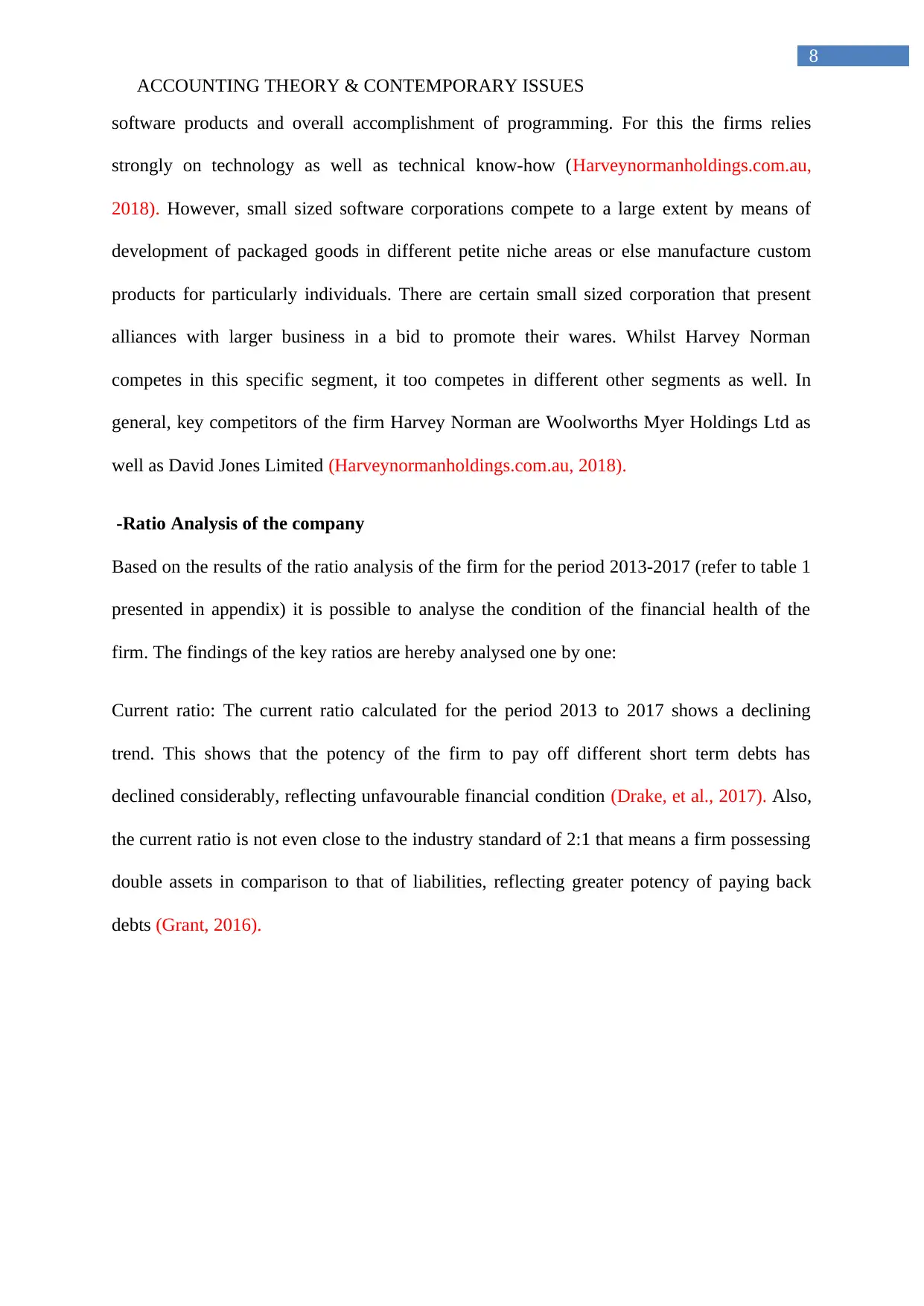
8
ACCOUNTING THEORY & CONTEMPORARY ISSUES
software products and overall accomplishment of programming. For this the firms relies
strongly on technology as well as technical know-how (Harveynormanholdings.com.au,
2018). However, small sized software corporations compete to a large extent by means of
development of packaged goods in different petite niche areas or else manufacture custom
products for particularly individuals. There are certain small sized corporation that present
alliances with larger business in a bid to promote their wares. Whilst Harvey Norman
competes in this specific segment, it too competes in different other segments as well. In
general, key competitors of the firm Harvey Norman are Woolworths Myer Holdings Ltd as
well as David Jones Limited (Harveynormanholdings.com.au, 2018).
-Ratio Analysis of the company
Based on the results of the ratio analysis of the firm for the period 2013-2017 (refer to table 1
presented in appendix) it is possible to analyse the condition of the financial health of the
firm. The findings of the key ratios are hereby analysed one by one:
Current ratio: The current ratio calculated for the period 2013 to 2017 shows a declining
trend. This shows that the potency of the firm to pay off different short term debts has
declined considerably, reflecting unfavourable financial condition (Drake, et al., 2017). Also,
the current ratio is not even close to the industry standard of 2:1 that means a firm possessing
double assets in comparison to that of liabilities, reflecting greater potency of paying back
debts (Grant, 2016).
ACCOUNTING THEORY & CONTEMPORARY ISSUES
software products and overall accomplishment of programming. For this the firms relies
strongly on technology as well as technical know-how (Harveynormanholdings.com.au,
2018). However, small sized software corporations compete to a large extent by means of
development of packaged goods in different petite niche areas or else manufacture custom
products for particularly individuals. There are certain small sized corporation that present
alliances with larger business in a bid to promote their wares. Whilst Harvey Norman
competes in this specific segment, it too competes in different other segments as well. In
general, key competitors of the firm Harvey Norman are Woolworths Myer Holdings Ltd as
well as David Jones Limited (Harveynormanholdings.com.au, 2018).
-Ratio Analysis of the company
Based on the results of the ratio analysis of the firm for the period 2013-2017 (refer to table 1
presented in appendix) it is possible to analyse the condition of the financial health of the
firm. The findings of the key ratios are hereby analysed one by one:
Current ratio: The current ratio calculated for the period 2013 to 2017 shows a declining
trend. This shows that the potency of the firm to pay off different short term debts has
declined considerably, reflecting unfavourable financial condition (Drake, et al., 2017). Also,
the current ratio is not even close to the industry standard of 2:1 that means a firm possessing
double assets in comparison to that of liabilities, reflecting greater potency of paying back
debts (Grant, 2016).
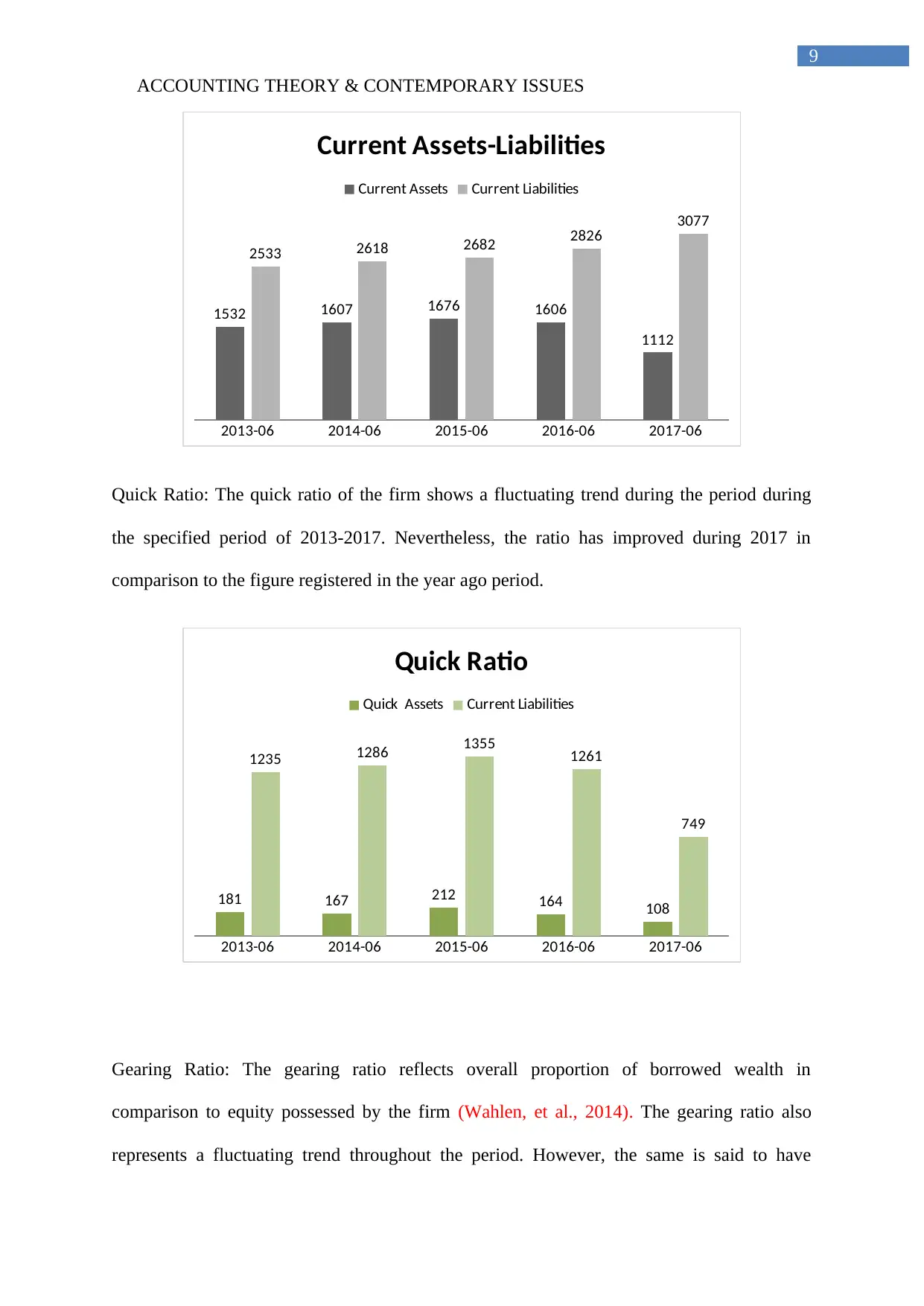
9
ACCOUNTING THEORY & CONTEMPORARY ISSUES
2013-06 2014-06 2015-06 2016-06 2017-06
1532 1607 1676 1606
1112
2533 2618 2682 2826 3077
Current Assets-Liabilities
Current Assets Current Liabilities
Quick Ratio: The quick ratio of the firm shows a fluctuating trend during the period during
the specified period of 2013-2017. Nevertheless, the ratio has improved during 2017 in
comparison to the figure registered in the year ago period.
2013-06 2014-06 2015-06 2016-06 2017-06
181 167 212 164 108
1235 1286 1355 1261
749
Quick Ratio
Quick Assets Current Liabilities
Gearing Ratio: The gearing ratio reflects overall proportion of borrowed wealth in
comparison to equity possessed by the firm (Wahlen, et al., 2014). The gearing ratio also
represents a fluctuating trend throughout the period. However, the same is said to have
ACCOUNTING THEORY & CONTEMPORARY ISSUES
2013-06 2014-06 2015-06 2016-06 2017-06
1532 1607 1676 1606
1112
2533 2618 2682 2826 3077
Current Assets-Liabilities
Current Assets Current Liabilities
Quick Ratio: The quick ratio of the firm shows a fluctuating trend during the period during
the specified period of 2013-2017. Nevertheless, the ratio has improved during 2017 in
comparison to the figure registered in the year ago period.
2013-06 2014-06 2015-06 2016-06 2017-06
181 167 212 164 108
1235 1286 1355 1261
749
Quick Ratio
Quick Assets Current Liabilities
Gearing Ratio: The gearing ratio reflects overall proportion of borrowed wealth in
comparison to equity possessed by the firm (Wahlen, et al., 2014). The gearing ratio also
represents a fluctuating trend throughout the period. However, the same is said to have
⊘ This is a preview!⊘
Do you want full access?
Subscribe today to unlock all pages.

Trusted by 1+ million students worldwide
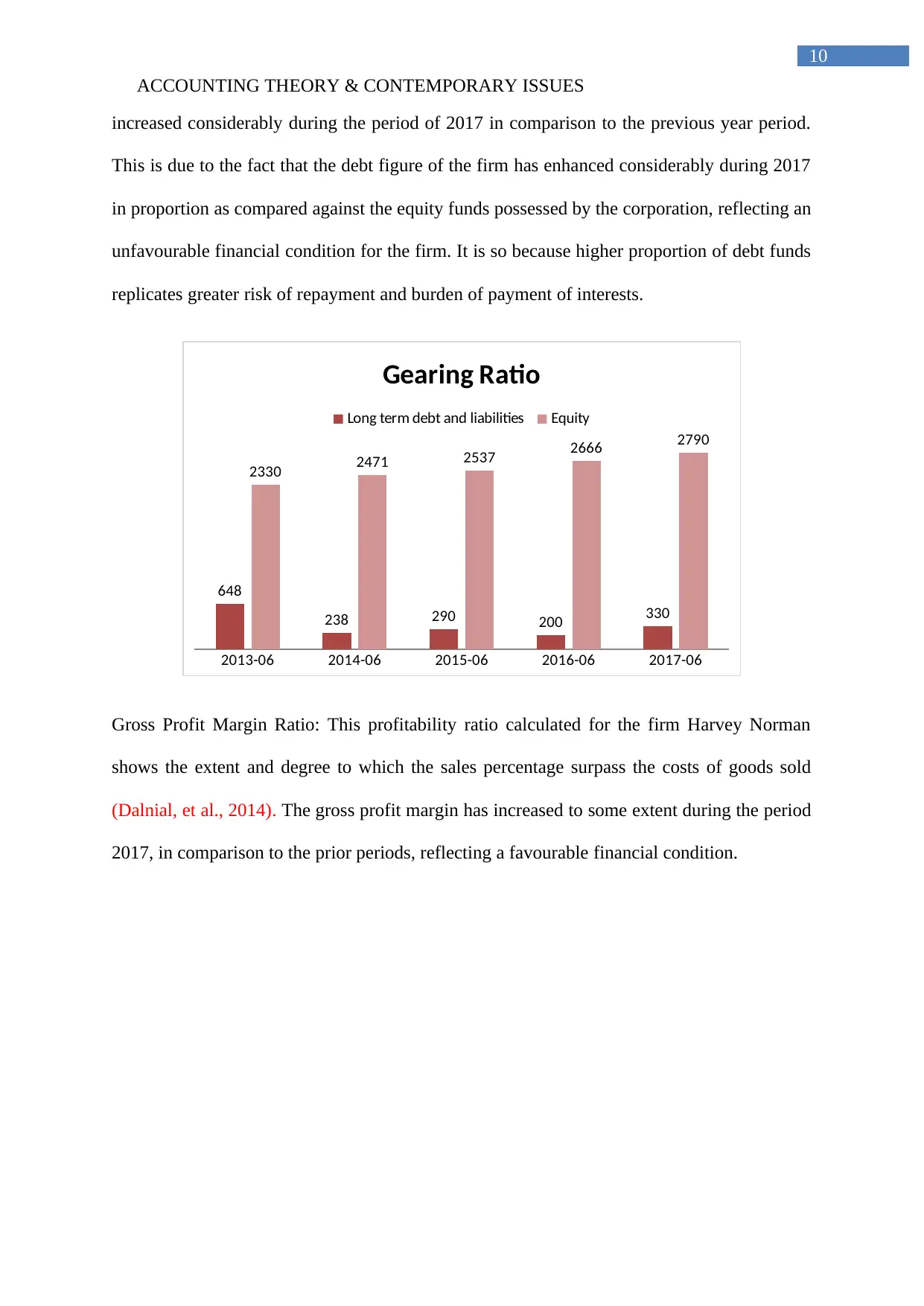
10
ACCOUNTING THEORY & CONTEMPORARY ISSUES
increased considerably during the period of 2017 in comparison to the previous year period.
This is due to the fact that the debt figure of the firm has enhanced considerably during 2017
in proportion as compared against the equity funds possessed by the corporation, reflecting an
unfavourable financial condition for the firm. It is so because higher proportion of debt funds
replicates greater risk of repayment and burden of payment of interests.
2013-06 2014-06 2015-06 2016-06 2017-06
648
238 290 200 330
2330 2471 2537 2666 2790
Gearing Ratio
Long term debt and liabilities Equity
Gross Profit Margin Ratio: This profitability ratio calculated for the firm Harvey Norman
shows the extent and degree to which the sales percentage surpass the costs of goods sold
(Dalnial, et al., 2014). The gross profit margin has increased to some extent during the period
2017, in comparison to the prior periods, reflecting a favourable financial condition.
ACCOUNTING THEORY & CONTEMPORARY ISSUES
increased considerably during the period of 2017 in comparison to the previous year period.
This is due to the fact that the debt figure of the firm has enhanced considerably during 2017
in proportion as compared against the equity funds possessed by the corporation, reflecting an
unfavourable financial condition for the firm. It is so because higher proportion of debt funds
replicates greater risk of repayment and burden of payment of interests.
2013-06 2014-06 2015-06 2016-06 2017-06
648
238 290 200 330
2330 2471 2537 2666 2790
Gearing Ratio
Long term debt and liabilities Equity
Gross Profit Margin Ratio: This profitability ratio calculated for the firm Harvey Norman
shows the extent and degree to which the sales percentage surpass the costs of goods sold
(Dalnial, et al., 2014). The gross profit margin has increased to some extent during the period
2017, in comparison to the prior periods, reflecting a favourable financial condition.
Paraphrase This Document
Need a fresh take? Get an instant paraphrase of this document with our AI Paraphraser
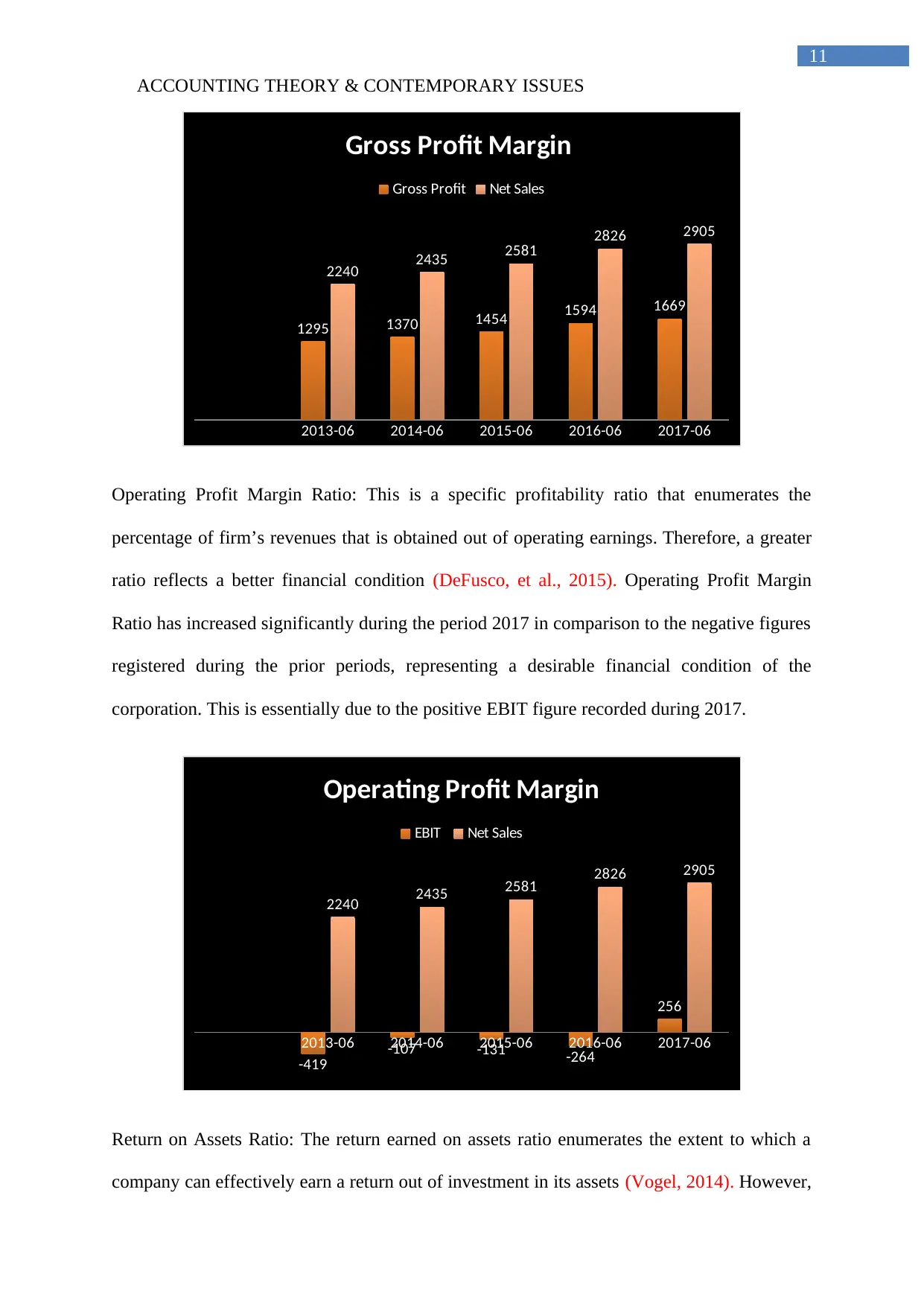
11
ACCOUNTING THEORY & CONTEMPORARY ISSUES
2013-06 2014-06 2015-06 2016-06 2017-06
1295 1370 1454 1594 1669
2240 2435 2581 2826 2905
Gross Profit Margin
Gross Profit Net Sales
Operating Profit Margin Ratio: This is a specific profitability ratio that enumerates the
percentage of firm’s revenues that is obtained out of operating earnings. Therefore, a greater
ratio reflects a better financial condition (DeFusco, et al., 2015). Operating Profit Margin
Ratio has increased significantly during the period 2017 in comparison to the negative figures
registered during the prior periods, representing a desirable financial condition of the
corporation. This is essentially due to the positive EBIT figure recorded during 2017.
2013-06 2014-06 2015-06 2016-06 2017-06
-419
-107 -131 -264
256
2240 2435 2581 2826 2905
Operating Profit Margin
EBIT Net Sales
Return on Assets Ratio: The return earned on assets ratio enumerates the extent to which a
company can effectively earn a return out of investment in its assets (Vogel, 2014). However,
ACCOUNTING THEORY & CONTEMPORARY ISSUES
2013-06 2014-06 2015-06 2016-06 2017-06
1295 1370 1454 1594 1669
2240 2435 2581 2826 2905
Gross Profit Margin
Gross Profit Net Sales
Operating Profit Margin Ratio: This is a specific profitability ratio that enumerates the
percentage of firm’s revenues that is obtained out of operating earnings. Therefore, a greater
ratio reflects a better financial condition (DeFusco, et al., 2015). Operating Profit Margin
Ratio has increased significantly during the period 2017 in comparison to the negative figures
registered during the prior periods, representing a desirable financial condition of the
corporation. This is essentially due to the positive EBIT figure recorded during 2017.
2013-06 2014-06 2015-06 2016-06 2017-06
-419
-107 -131 -264
256
2240 2435 2581 2826 2905
Operating Profit Margin
EBIT Net Sales
Return on Assets Ratio: The return earned on assets ratio enumerates the extent to which a
company can effectively earn a return out of investment in its assets (Vogel, 2014). However,
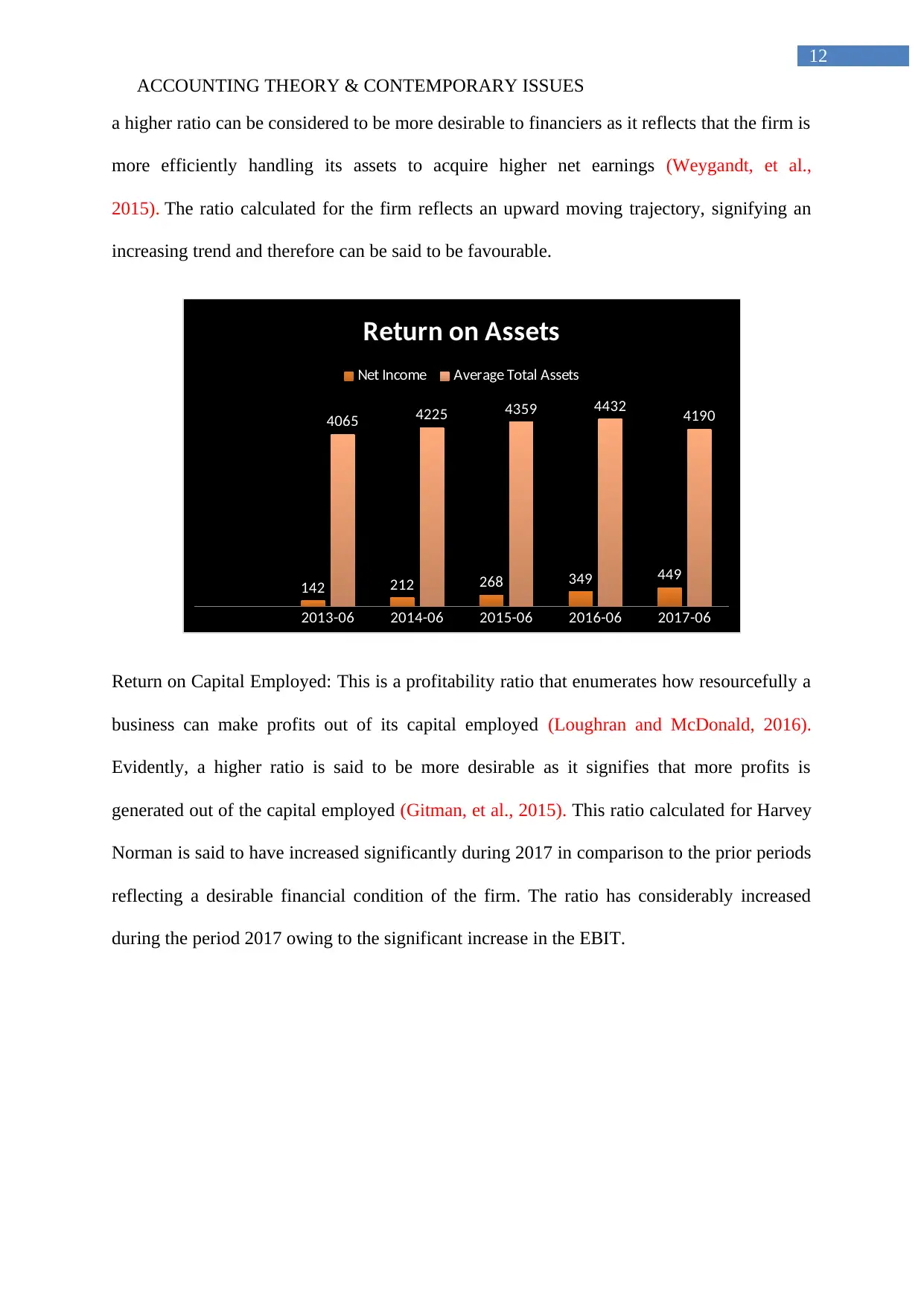
12
ACCOUNTING THEORY & CONTEMPORARY ISSUES
a higher ratio can be considered to be more desirable to financiers as it reflects that the firm is
more efficiently handling its assets to acquire higher net earnings (Weygandt, et al.,
2015). The ratio calculated for the firm reflects an upward moving trajectory, signifying an
increasing trend and therefore can be said to be favourable.
2013-06 2014-06 2015-06 2016-06 2017-06
142 212 268 349 449
4065 4225 4359 4432 4190
Return on Assets
Net Income Average Total Assets
Return on Capital Employed: This is a profitability ratio that enumerates how resourcefully a
business can make profits out of its capital employed (Loughran and McDonald, 2016).
Evidently, a higher ratio is said to be more desirable as it signifies that more profits is
generated out of the capital employed (Gitman, et al., 2015). This ratio calculated for Harvey
Norman is said to have increased significantly during 2017 in comparison to the prior periods
reflecting a desirable financial condition of the firm. The ratio has considerably increased
during the period 2017 owing to the significant increase in the EBIT.
ACCOUNTING THEORY & CONTEMPORARY ISSUES
a higher ratio can be considered to be more desirable to financiers as it reflects that the firm is
more efficiently handling its assets to acquire higher net earnings (Weygandt, et al.,
2015). The ratio calculated for the firm reflects an upward moving trajectory, signifying an
increasing trend and therefore can be said to be favourable.
2013-06 2014-06 2015-06 2016-06 2017-06
142 212 268 349 449
4065 4225 4359 4432 4190
Return on Assets
Net Income Average Total Assets
Return on Capital Employed: This is a profitability ratio that enumerates how resourcefully a
business can make profits out of its capital employed (Loughran and McDonald, 2016).
Evidently, a higher ratio is said to be more desirable as it signifies that more profits is
generated out of the capital employed (Gitman, et al., 2015). This ratio calculated for Harvey
Norman is said to have increased significantly during 2017 in comparison to the prior periods
reflecting a desirable financial condition of the firm. The ratio has considerably increased
during the period 2017 owing to the significant increase in the EBIT.
⊘ This is a preview!⊘
Do you want full access?
Subscribe today to unlock all pages.

Trusted by 1+ million students worldwide
1 out of 22
Related Documents
Your All-in-One AI-Powered Toolkit for Academic Success.
+13062052269
info@desklib.com
Available 24*7 on WhatsApp / Email
![[object Object]](/_next/static/media/star-bottom.7253800d.svg)
Unlock your academic potential
Copyright © 2020–2025 A2Z Services. All Rights Reserved. Developed and managed by ZUCOL.





